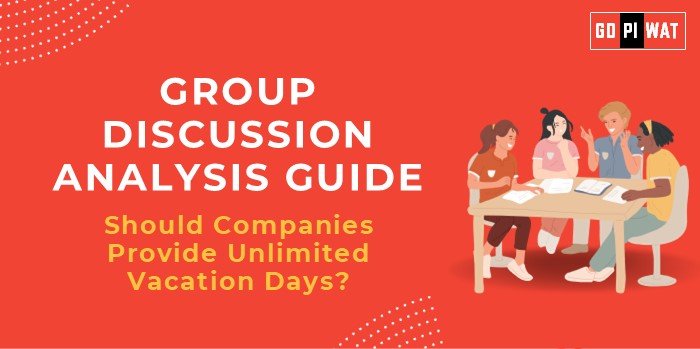📋 Group Discussion (GD) Analysis Guide: Should Companies Provide Unlimited Vacation Days?
🌐 Introduction
Opening Context: Unlimited vacation policies are a bold initiative that aligns with changing workplace norms, especially as companies strive to attract and retain top talent in competitive markets. Such policies reflect an evolving focus on employee well-being and autonomy.
Topic Background: The concept gained traction with companies like Netflix and Virgin implementing unlimited vacation days, aiming to empower employees with greater flexibility. However, questions about effectiveness, productivity, and cultural fit persist.
📊 Quick Facts and Key Statistics
- 📈 Adoption Rate: Only 2% of companies globally offer unlimited vacation policies (SHRM, 2023).
- 📉 Productivity Impact: 20% of employees take fewer vacation days under such policies due to guilt or unclear boundaries (Harvard Business Review, 2023).
- 📋 Talent Attraction: Companies with flexible vacation policies report a 25% increase in job applications (LinkedIn Data, 2023).
- 🌍 Regional Trends: European companies are less likely to adopt these policies due to stringent labor laws mandating paid leave.
🤝 Stakeholders and Their Roles
- 🏢 Corporations: Innovating workplace policies to attract talent and increase retention.
- 👩💼 Employees: Balancing autonomy with workplace expectations.
- 📊 HR Leaders: Designing and monitoring policy effectiveness.
- ⚖️ Regulators: Ensuring policies align with labor laws.
- 🏆 Competitors: Assessing the viability and competitive advantage of implementing similar policies.
🏆 Achievements and Challenges
✨ Achievements:
- 🌟 Employee Well-Being: Improved mental health and work-life balance in companies with effective implementation.
- 🎯 Talent Acquisition: Attracts high-performing professionals, especially in tech and creative industries.
- 🌍 Cultural Shift: Promotes trust and autonomy in the workplace.
⚠️ Challenges:
- ❓ Underutilization: Employees often feel hesitant to take vacations without clear norms.
- 📌 Equity Concerns: May disproportionately benefit employees in roles with less workload variability.
- 🌎 Global Differences: Cultural and regulatory variations impact adoption.
🌍 Global Comparisons:
- ✅ Success: Netflix’s implementation has been hailed as a model of autonomy fostering productivity.
- ❌ Challenges: Attempts in Japan struggled due to a cultural preference for defined work norms.
Case Study: HubSpot demonstrated a 12% increase in employee satisfaction but found discrepancies in vacation usage between teams.
📄 Structured Arguments for Discussion
- 🟢 Supporting Stance: “Unlimited vacation policies empower employees, enhance well-being, and foster a culture of trust.”
- 🔴 Opposing Stance: “These policies risk ambiguity, leading to underutilization and inequality across teams.”
- ⚖️ Balanced Perspective: “While promising, success depends on clear communication and cultural alignment.”
🚀 Effective Discussion Approaches
🔑 Opening Approaches:
- 📌 Data-Driven: “With only 2% of companies adopting unlimited vacation policies, is this the future of work or a passing trend?”
- 🌍 Cultural Perspective: “Unlimited vacation reflects a trust-based work culture, but is it suitable for every organization?”
- 📖 Case Study: “HubSpot’s 12% increase in employee satisfaction raises questions about scalability and equity.”
🤔 Counter-Argument Handling:
Highlight examples of successful and failed implementations. Acknowledge limitations while suggesting structured solutions like vacation tracking tools.
📈 Strategic Analysis of Strengths and Weaknesses
- 💪 Strengths: Employee autonomy, enhanced attraction of top talent, and flexibility.
- ⚠️ Weaknesses: Underutilization, unclear boundaries, and managerial oversight.
- 💡 Opportunities: Expansion in creative and tech sectors.
- 🚧 Threats: Legal scrutiny and cultural misalignment.
📚 Connecting with B-School Applications
Real-World Applications:
- 📖 Case studies for HR strategy, leadership development, and corporate policy innovation.
📌 Sample Interview Questions:
- 💼 “How can unlimited vacation policies improve workplace culture?”
- 📊 “What metrics would you use to evaluate the success of such a policy?”
Insights for B-School Students:
- 🌟 Focus on alignment of HR policies with corporate strategy and employee engagement.


